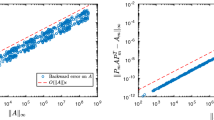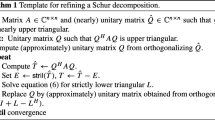Abstract
In Demmel et al. (Numer. Math. 106(2), 199–224, 2007) we showed that a large class of fast recursive matrix multiplication algorithms is stable in a normwise sense, and that in fact if multiplication of n-by-n matrices can be done by any algorithm in O(n ω+η) operations for any η > 0, then it can be done stably in O(n ω+η) operations for any η > 0. Here we extend this result to show that essentially all standard linear algebra operations, including LU decomposition, QR decomposition, linear equation solving, matrix inversion, solving least squares problems, (generalized) eigenvalue problems and the singular value decomposition can also be done stably (in a normwise sense) in O(n ω+η) operations.
Similar content being viewed by others
References
Anderson, E., Bai, Z., Bischof, C., Demmel, J., Dongarra, J., Du Croz, J., Greenbaum, A., Hammarling, S., McKenney, A., Blackford, S., Sorensen, D.: LAPACK Users’ Guide, 3rd edn. SIAM, Philadelphia (1999)
Anderson T.W., Olkin I. and Underhill L.G. (1987). Generation of random orthogonal matrices. SIAM J. Sci. Stat. Comput. 8: 625–629
Bai, Z., Demmel, J.: Design of a parallel nonsymmetric eigenroutine toolbox, Part I. In: Proceedings of the Sixth SIAM Conference on Parallel Processing for Scientific Computing. SIAM. Long version available as UC Berkeley Computer Science report all.ps.Z via anonymous ftp from tr-ftp.cs.berkeley.edu, directory (1993) pub/tech-reports/csd/csd-92-718
Bai, Z., Demmel, J.: Using the matrix sign function to compute invariant subspaces. SIAM J. Mat. Anal. Appl. 19 (1), 1998. Technical report title “Design of a Parallel Nonsymmetric Eigenroutine Toolbox, Part II”
Bai, Z., Demmel, J., Gu, M.: Inverse free parallel spectral divide and conquer algorithms for nonsymmetric eigenproblems. Numer. Math. 76, 279–308, (1997). UC Berkeley CS Division Report UCB//CSD-94-793, Feb 94
Bini D. and Lotti D. (1980). Stability of fast algorithms for matrix multiplication. Numer. Math. 36: 63–72
Bischof, C., Huss-Lederman, S., Sun, X., Tsao, A.: The PRISM project: Infrastructure and algorithms for parallel eigensolvers. In: Proceedings of the Scalable Parallel Libraries Conference, Mississippi State, Mississippi. IEEE Computer Society, 1993
Bischof C. and Quintana-Orti G. (1998). Computing rank-revealing QR factorizations of dense matrices. ACM Trans. Math. Softw. 24(2): 226–253
Bischof, C., Van Loan, C.: The WY representation for products of Householder matrices. SIAM J. Sci. Stat. Comput. 8(1), (1987)
Blackford, L.S., Choi, J., Cleary, A., E. D’Azevedo, Demmel, J., Dhillon, I., Dongarra, J., Hammarling, S., Henry, G., Petitet, A., Stanley, K., Walker, D., Whaley, R.C.: ScaLAPACK Users’ Guide. SIAM, Philadelphia (1997)
Borodin A. and Munro I. (1975). The Computational Complexity of Algebraic and Numeric Problems. American Elsevier, Amsterdam
Brent, R.P.: Algorithms for matrix multiplication, Report CS 157. Computer Science Department, Stanford University (1970)
Bulgakov A.Ya. and Godunov S.K. (1988). Circular dichotomy of the spectrum of a matrix. Siberian Math. J. 29(5): 734–744
Bürgisser P., Clausen M. and Shokrollahi M.A. (1997). Algebraic Complexity Theory. Springer, Berlin
Chan T. (1987). Rank revealing QR factorizations. Linear Algebra Appl. 88(89): 67–82
Chandrasekaran S. and Ipsen I. (1994). On rank-revealing QR factorizations. SIAM J. Matrix Anal. Appl. 15(2): 592–622
Cohn, H., Kleinberg, R., Szegedy, B., Umans, C.: Group-theoretic algorithms for matrix multiplication. In: Foundations of Computer Science. 46th Annual IEEE Symposium on 23–25 October 2005, pp. 379–388 (2005)
Cohn, H., Umans, C.: A group-theoretic approach to matrix multiplication. In: Foundations of Computer Science. 44th Annual IEEE Symposium, pp. 438–449 (2003)
Coppersmith D. and Winograd S. (1990). Matrix multiplication via arithmetic progressions. J. Symbolic Comput. 9(3): 251–280
Cormen R., Leiserson C. and Rivest R. (1990). Algorithms. MIT/McGraw-Hill, Cambridge/New York
Day, D.: How the QR algorithm fails to converge and how to fix it. Technical Report 96-0913J, Sandia National Laboratory, April 1996
Demmel, J.: Applied Numerical Linear Algebra. SIAM, 1997
Demmel J., Dumitriu I., Holtz O. and Kleinberg R. (2007). Fast matrix multiplication is stable. Numer. Math. 106(2): 199–224
Demmel J. and Higham N.J. (1992). Stability of block algorithms with fast level 3 BLAS. ACM Trans. Math. Softw. 18: 274–291
Demmel J., Higham N.J. and Schreiber R. (1995). Stability of block LU factorization, Numer. Linear Algebra Appl. 2(2): 173–190
Edelman A. (1988). Eigenvalues and condition numbers of random matrices. SIAM J. Math. Anal. Appl. 9(4): 543–560
Elmroth E. and Gustavson F. (2000). Applying recursion to serial and parallel QR factorization. IBM J. Res. Devel. 44(4): 605–624
Godunov S.K. (1986). Problem of the dichotomy of the spectrum of a matrix. Siberian Math. J. 27(5): 649–660
Golub G. and Van Loan C. (1996). Matrix Computations, 3rd edn. Johns Hopkins University Press, Baltimore
Gu M. and Eisenstat S. (1996). An efficient algorithm for computing a strong rank–revealing QR factorization. SIAM J. Sci. Comput. 17(4): 848–869
Heller D. (1978). A survey of parallel algorithms in numerical linear algebra. SIAM Rev. 20: 740–777
Higham N. (1995). Stability of parallel triangular matrix systems solvers. SIAM J. Sci. Comput. 16(2): 400–413
Higham N.J. (1990). Exploiting fast matrix multiplication within the Level 3 BLAS. ACM Trans. Math. Softw. 16: 352–368
Higham, N.J.: Accuracy and stability of numerical algorithms, 2nd edn. SIAM, Philadelphia, PA (2002)
Hong P. and Pan C.T. (1992). Rank-revealing QR factorizations and the singular value decomposition. Math. Comput. 58: 213–232
Huss S., Quintana E.S., Sun X. and Wu J. (2000). Parallel spectral division using the matrix sign function for the generalized eigenproblem. Int. J. High Speed Comput. 11(1): 1–14
Huss-Lederman, S., Tsao, A., Zhang, G.: A parallel implementation of the invariant subspace decomposition algorithm for dense symmetric matrices. In: Proceedings of the Sixth SIAM Conference on Parallel Processing for Scientific Computing. SIAM, 1993
Malyshev A.N. (1989). Computing invariant subspaces of a regular linear pencil of matrices. Siberian Math. J. 30(4): 559–567
Malyshev, A.N.: Guaranteed accuracy in spectral problems of linear algebra, I,II. Siberian Adv. Math. 2 (1,2), 144–197, 153–204 (1992)
Malyshev, A.N.: Parallel algorithm for solving some spectral problems of linear algebra. Linear Algebra Appl. 188,189, 489–520 (1993)
Muirhead R.J. (1982). Aspects of Multivariate Statistical Theory. Wiley, New York
PRISM: Parallel Research on Invariant Subspace Methods. www-unix.mcs.anl.gov/prism
Ran Raz.: On the complexity of matrix product. SIAM J. Comput. 32(5), 1356–1369 (electronic), (2003)
Roberts J. (1980). Linear model reduction and solution of the algebraic Riccati equation. Inter. J. Control 32: 677–687
Schönhage A. and Strassen V. (1971). Schnelle Multiplikation grosser Zahlen. Computing (Arch. Elektron. Rechnen) 7: 281–292
Schreiber R. and Van Loan C. (1989). A storage efficient WY representation for products of Householder transformations. SIAM J. Sci. Stat. Comput. 10: 53–57
Stewart G.W. (1993). Updating a rank-revealing ULV decomposition. SIAM J. Math. Anal. Appl. 14(2): 494–499
Stewart G.W. (1980). The efficient generation of random orthogonal matrices with an application to condition estimation. SIAM J. Numer. Anal. 17: 403–409
Strassen V. (1969). Gaussian elimination is not optimal. Numer. Math. 13: 354–356
Toledo S. (1997). Locality of reference in LU decomposition with partial pivoting. SIAM J. Math. Anal. Appl. 18(4): 1065–1081
Varah J. (1979). On the separation of two matrices. SIAM J. Numer. Anal. 16: 216–222
Author information
Authors and Affiliations
Corresponding author
Additional information
J. Demmel acknowledges support of NSF under grants CCF-0444486, ACI-00090127, CNS-0325873 and of DOE under grant DE-FC02-01ER25478.
Rights and permissions
About this article
Cite this article
Demmel, J., Dumitriu, I. & Holtz, O. Fast linear algebra is stable. Numer. Math. 108, 59–91 (2007). https://doi.org/10.1007/s00211-007-0114-x
Received:
Revised:
Published:
Issue Date:
DOI: https://doi.org/10.1007/s00211-007-0114-x




